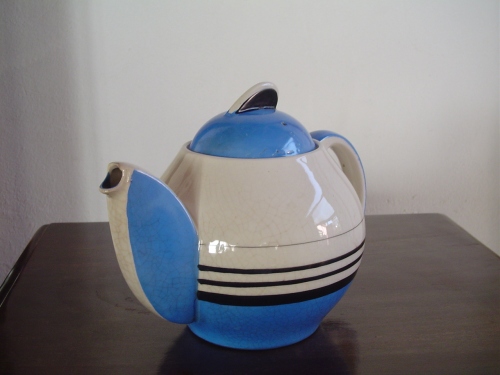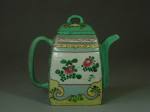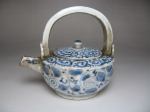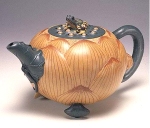This old Japanese umbrella is made from a heavy rice paper hand painted with peacocks and flowers. It has a bamboo handle and a metal cap on top. For being over 100 years old this “wagasa” is in good condition.
Wagasa – Traditional Japanese Umbrellas
Since its introduction to Japan over 1000 years ago, the Japanese have gone beyond seeing the umbrella as merely a tool. Indeed, they are objects of beauty in their own right.
Traditional Japanese umbrellas or Wagasa (和傘), are made of bamboo (竹), wood, and washi (和纸: Japanese traditional paper), fortified and made waterproof with persimmon, linseed oil and China wood oil.
There are many types of Japanese umbrella:
Bangasa (番伞): traditional rain umbrella made of bamboo and oiled paper.
Janome (蛇の目: umbrella in snake eye pattern): is blue in the center and at the edges, and white in between, and looks like the eye of a snake when viewed from above. This umbrella does have variations, such as painted black rings on the surface and the application of other materials.
Maigasa (舞伞) or Buyôgasa (舞踊伞): is a wonderful parasol used traditionally for classical Japanese dance, is more lightweight in nature, allowing for delicate and graceful moves. Maigasa is status symbol of “mai”(舞) dancer but not be used in the rain.
Nodategasa (野点傘): is a type of umbrella used for shade in Japanese processions and open air tea ceremonies (茶の湯).
While a typical western umbrella has eight ribs holding up the covering, a traditional Japanese umbrella has 30-40 ribs. This is due to the particular structure of these umbrellas, wherein thin bamboo ribs positioned closely together support and push the washi paper outwards to open.
The ribs of a Japanese umbrella are made of a single bamboo cane, which is split lengthways into equal-sized pieces. When attaching these ribs to the covering, they are rearranged back into the order in which they were split, so that when the umbrella is closed, it closes neatly with the bamboo pieces coming together to form the shape of the original cane. Its composition is so delicate that if there is even the slightest damage to the bamboo or a miscalculation with the rearrangement occurs, the umbrella will not open.The geometrically spaced ribs beautifully spread out from the center to create an elegant shape.
When closed, bamboo is strong and durable more than expected, due to being transformed into a form of its bamboo cylinder.
When opened, however, it is not strong enough due to thin bamboo ribs connected with the threads with washi paper glued to the frames, which requires good care for a longer use. If kept in good shape, a 20 year old umbrella may be usable to your surprise. Wagasa may look simple, but it requires a complex technique since paper must be folded nicely after it is pasted on the frame.

The umbrella was invented in ancient China as a canopy to be held over a nobleman. It was introduced to Japan through Kudara (the Korean peninsula) as part of Buddhist ceremonies. Originating in the Kamakura era (镰仓时代: 1192-1333), it flourished in the Edo era (江戸时代: 1603-1867).
The umbrella in Japan was originally called “kinugasa”, but because it came from China (kara), it was also called “karakasa”. At the time, they were unlike umbrellas used today, and were more like canopies that could not be opened and closed. Their purpose was also different. These umbrellas were reserved for privileged members of society, and as well having the conventional function of a parasol, the umbrella was a status symbol that was believed to ward off evil spirits.
The umbrella has played an important role in Japanese culture, and its “Umbrella Culture” is without parallel in the rest of the world. Not only is it indispensable in everyday life for protection against rain and sun, the wagasa is also used in the world of traditional arts, such as in Noh and Kabuki theatre.
Currently, the kano umbrella, made in Kano, Gifu Prefecture, is proud to be to the only place in Japan to be a major producer of traditional Japanese umbrellas.
Umbrellas & Art
































































































